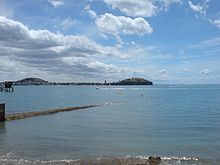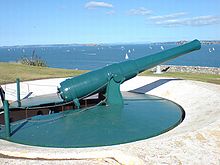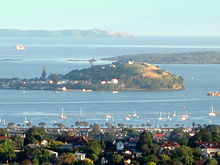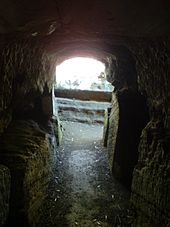- North Head, New Zealand
-
 North Head as seen from the south from Tamaki Drive. To the west, Mount Victoria is visible.
North Head as seen from the south from Tamaki Drive. To the west, Mount Victoria is visible.
 The BL 8 inch Mk VII of the South Battery, a well-preserved example of a disappearing gun.
The BL 8 inch Mk VII of the South Battery, a well-preserved example of a disappearing gun.
North Head (or Maungauika, the Mountain of Uika in Māori[1]) is a volcanic cone forming a headland within North Shore City, New Zealand, in the suburb of Devonport at the east end of the Waitemata Harbour (Auckland's harbour).
It is a public reserve (part of the Hauraki Gulf Maritime Park) known for its sweeping views over the harbour and the Hauraki Gulf. During the last century it was mainly used by the military for coastal defense installation, which left a network of accessible old bunkers and tunnels as its legacy, forming part of the attraction.
Contents
History
Māori usage
The original scoria cone has been substantially altered, first by marine erosion and later by the various generations of people who have occupied the headland. It was first used by Māori, one of whose ancestral waka canoes was reputed to have put ashore close by.[citation needed] Some early photographs of the area show that they used to work gardens on the hill's lower slopes, though the pā fortifications of other cones in the area seem absent. European visitors during the 1850s have also described a settlement at the foot of the hill with gardens and racks for the drying of fish.[1]
Military usage
The settlement of Auckland saw the area used as the first pilot station for the guiding of ships into the harbour. In 1878, the area was then set aside as a public reserve - with the stipulation that if necessary, it could be re-appropriated and used for defence purposes by the New Zealand Army. In 1885, this then became reality, with the Russian scare reaching its height and forts being built in various places around Auckland, to deter the anticipated invaders from the far north.[1]
Three large gun batteries were erected: North Battery facing over the Rangitoto Channel, South Battery facing over the inner harbour, and Summit/Cautley Battery on the top of the hill. These first fortifications were hastily constructed, but later expanded and strengthened over 25 years by convict labor of up to 40 prisoners living in a barracks on the hilltop. They added extensive tunnel systems, underground store rooms and various observation posts. The armaments of the fort included 64 pounder Armstrong disappearing guns, searchlights and a remote-detonated naval minefield across the inner harbour to Bastion Point. None of the armaments were ever used in anger.[1] A four-gun memorial saluting battery of 18 pounder World War I field guns was used, among other occasions to salute Queen Elizabeth II on her visit in 1953.[2]
In the 1930s, part of the fort was modernised, and during World War II, it became the administrative centre of Auckland's coast defenses, with the regimental headquarters buildings still surviving today. The coastal defences were scrapped in 1950, though one of the disappearing guns remained behind - obsolete and too difficult for the scrap merchant who bought it to disassemble and remove.[3] After the army had left, the area was turned into a reserve again, though the New Zealand Navy kept an area around the summit for a training school.[1]
Modern usage
Since the Navy school left the summit area in 1996, the whole area has been administered by the Department of Conservation as a reserve, and provides for beautiful walks along the waterline or onto the summit with good views of Rangitoto and Auckland due the prominent height of the hill. Also popular are exploratory forays to the gun emplacements and into the tunnel system, which is open to the public to a substantial degree, though torches are needed to explore it.
In the late 1980s and early 1990s there were reports of strange chemical smells and rumours of hidden caverns underneath the hill. Some tales even told of airplanes hidden in secret storerooms. As it was feared that old ammunition was decaying in forgotten parts of the fortifications, a major investigation was started, involving documentary research, geological tests and substantial exploratory digging was done around the hill. The research however, found little of new import.[1][2]
See also
 Media related to North Head, New Zealand at Wikimedia Commons
Media related to North Head, New Zealand at Wikimedia CommonsReferences
- Volcanoes of Auckland: The Essential guide - Hayward, B.W., Murdoch, G., Maitland, G.; Auckland University Press, 2011.
External links
Coordinates: 36°49′40″S 174°48′43″E / 36.827751°S 174.81205°E
Categories:- Auckland Volcanic Field
- Buildings and structures in Auckland
- NZHPT Category I listings in the Auckland Region
- Headlands of New Zealand
- Military history of New Zealand
- New Zealand Army
- Royal New Zealand Navy
- Visitor attractions in Auckland
- North Shore City
- Forts in New Zealand
- Coastal artillery
- Lookouts in Auckland
Wikimedia Foundation. 2010.


